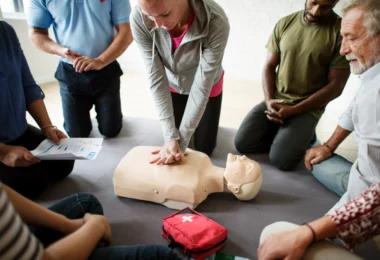If your goal is to get off to a good start in the world of home electrical systems, the Free online course for Residential Electricians GINEAD offers a direct path: structured content, immediate access, and the possibility of... optional digital certificate to verify your studies. The platform centralizes everything in a simple learning environment, with quick enrollment and study at your own pace.
Below you will find a complete guide: course details, what to practice, how certification works, who it is suitable for and, most importantly, The step-by-step process for enrolling..

What this course offers
The program is 100% online, with free access to the material and the assessment.The indicated workload for the certificate is... 60 hours, and the A digital certificate is a paid service. (reported rate of R$ 49.70The topics covered range from fundamentals (voltage, current, power) to conductor sizing. DR/IDRDistribution panel, wiring diagrams and material take-off, that is, from concept to residential application.
Why it's worth it (besides "it's free")
Learning through an organized learning path avoids common mistakes and reinforces safe procedures before any intervention. The course brings together... essential content (Electrical fundamentals, protection, sizing, symbology and documentation) that help to diagnose, plan and execute Typical residency activities, with a solid theoretical foundation to support the practice.

Immediate benefits for everyday life:
-
To understand protections (circuit breakers, RCDs/RCCBs) and when to apply them.
-
To know to size Circuits and conductors designed with care, reducing rework.
-
To create maps of the board and to standardize circuit identification.
-
To study whenever and wherever you wantThere is no cost to access the material and take the assessment.
How does the course work?
The logic is progressive: you start with basic concepts, move on to protection and distribution, and finish with calculation and dimensioning. The page itself lists the modules, including: Voltage/current, power, power factor, load calculation, service entrance, distribution panel, thermomagnetic circuit breakers and RCDs/RCCBs, distribution circuits and terminals, symbology, conductors (phase, neutral and protective), conduit planning, wiring diagrams, plan representation, current and power calculations, sizing (conductors, circuit breakers, RCDs), protective conductor cross-section, conduit sizing and material take-off..
Besides being free course — You organize your schedule; the methodology reinforces individualized study, careful reading, and completion of tasks. online assessment When you're ready.
Practical techniques for training while studying
To "turn theory into practice," try assembling a practical kit while navigating through the modules:
-
Safety checklist (PPE, voltage absence test, lockout/tagout, area cleaning and organization).
-
Measurements with a multimeter: voltage between phase-neutral/phase-ground, continuity of protective conductor (on a test bench, always with the circuit de-energized).
-
Map of the paintingIdentify each circuit breaker and its respective circuit/environment; record the estimated current and any observations.
-
Simple diagramsLighting with one and two sections, general and specific purpose outlets, with basic representation in plan view.
-
Mini-design of a roomLoad calculation, current estimation, circuit breaker selection and gauge (according to what the course presents).
Certificate: when (and how) to issue it
Issuing the certificate It's optional.After completing the content and to be approved In the evaluation, you can request the Digital Certificate in the student environment. The indicated rate is R$ 49.70, based on the legal basis of free course (LDB/Decree/Resolution), and the general rule for GINEAD approval requires minimum grade of 60%, with the possibility of retaking the test until you pass.
Who is this course suitable for?
The trail meets beginners who want to get started safely, professionals in transition who wish to add residential electrical services to their portfolio, self-employed who perform small services and students Those interested in consolidating fundamentals before moving on to related areas (controls, automation, photovoltaics).
Step-by-step guide to enrolling
-
Open the course page “Free Online Course for Residential Electricians” and click on Enroll in this course — Start studying now!. Click to register.
-
Create your account (or Log in) to confirm enrollment and unlock the learning environment. There is a official tutorial with the registration and access flow.
-
After enrolling, access the menu. "My Courses" To access the content, download the workbook and track your progress.
-
Study at your own pace. and do the online assessment When you're ready. If approved, you can start now. request the digital certificate (optional).
Frequently Asked Questions
Is it really free?
Yes. The access to the material of the course and to online assessment It's free. A digital certificate is optional and requires a fee. (R$ rate 49.70).
What is the workload?
THE The required course load for certification is 60 hours., as per the course page.
What is the minimum passing grade?
The general rules of GINEAD indicate minimum average of 60%If the student fails, they can redo the assessment until it is approved.
How long will I have access?
The website provides two pieces of information: 1 year of access to the course and indefinite period for the textbook. Therefore, confirm in your dashboard which will be in effect for your enrollment.
Is the certificate valid?
It is a certificate of free course Based on legal grounds (LDB/Decree/Resolution). It can be used for resumes, supplementary hours, and may count towards... title in competitionsif the notice to allow.
Can I enroll in multiple courses?
Yes, the platform indicates that it is possible to enroll in as many courses as you want.
If your goal is to win security and method Before getting your hands dirty, this course covers the most important aspects of daily work: fundamentals, electrical protection, sizing, and proper documentation—all online and free to start. Enroll now, organize a short schedule (for example, 1–2 hours per dayand start creating your practical kit (checklists, whiteboards and small diagrams) as you go. When you need to prove your training, issue the certificate and attach it to your resume.




